What terms are used to describe different types of spin on the cue ball, and what is english used for?
English or “side” refers to sidespin applied to the cue ball (CB) by hitting left or right of the cue-ball vertical centerline. Proper usage suggests the term “english” is preferable to “English” for describing sidespin, but “English” is also commonly used. See VEPS II – English and Position Control for complete descriptions, illustrations, and demonstrations of all english-related concepts and terminology with shot examples.
Here are the different names used to refer to the type of english:
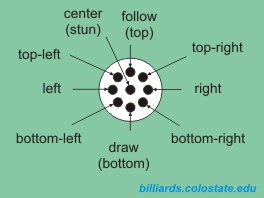
The purpose for sidespin is to alter the path the CB takes when it hits the rail cushions:
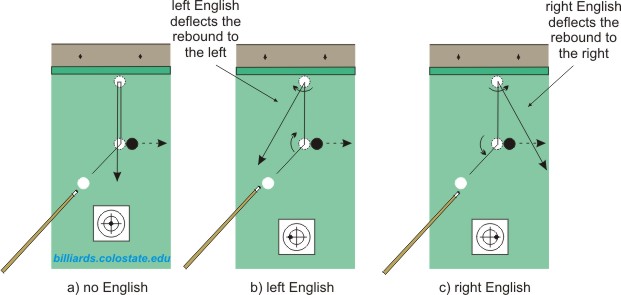
Here are some good resources and demonstrations to help you understand when and how sidespin is used:
- sidespin tutorial
- english quick-reference sheet
- english terminology handout
- english drill
- NV 4.10 – Effect of left english
- NV 4.11 – Effect of right english
- NV 4.25 – Positioning the cue ball at all spots on the table from an easy side-pocket shot
- NV B.73 – Leaving an angle and coming into the line of a shot, from VEPS II
- NV B.74 – Center-of-table position and routes, with the 45° rule, from VEPS II
- NV G.4 – How to Use Cue Ball Drag to Enhance Sidespin in 8-ball, from Vol. II of VEEB
- NV G.5 – How to Use Spin-Induced Throw (SIT) to Hold the Cue Ball in 8-ball, from Vol. II of VEEB
- NV I.6 – Common Two-Rail Position Plays in 9-ball and 10-ball, an excerpt from VENT-III
- NV I.7 – Common End-Game Patterns in 9-ball and 10-ball, an excerpt from VENT-III
And the following videos show some examples of when and how sidespin should and should not be used:
For more examples and information, see:
- cue ball control
- VEPP II – Position Control and English
- throw shots, spin transfer shots, rail cut shots, and massé shots
- Vol. III of the Video Encyclopedia of Nine-ball and Ten-ball (VENT)
Per the diagrams below, english (sidespin) is given different names (inside, outside, running, and reverse) based on how it is used.
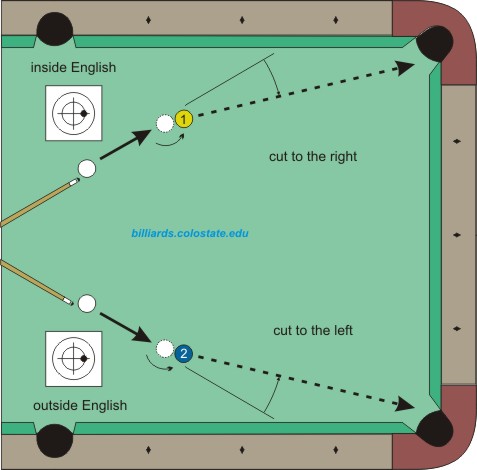
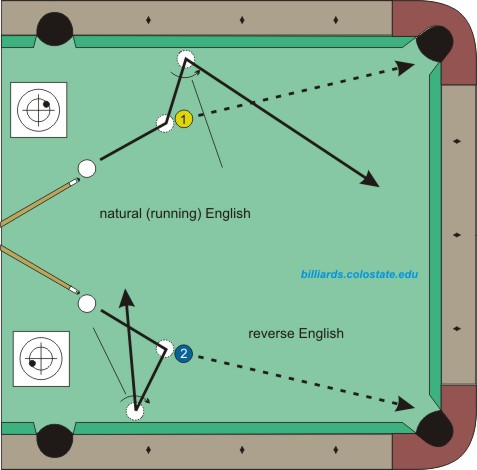
Here are definitions from the online pool glossary:
inside english (IE): sidespin created by hitting the cue ball on the side towards the direction of the shot (i.e., on the “inside” of the cue ball). For example, when the cue ball strikes an object ball on the left side, creating a cut shot to the right, right sidespin would be called “inside english.”
outside english (OE): sidespin created by hitting the cue ball on the side away from the direction of the shot (i.e., on the “outside” of the cue ball). For example, when the cue ball strikes an object ball on the left side, creating a cut shot to the right, left sidespin would be called “outside english.”
reverse english (AKA “hold-up” or “check” english): sidespin where the cue ball slows and has a smaller rebound angle after hitting a cushion (i.e., the opposite of “natural” or “running” english). The spin is in the direction opposite from the “rolling” direction along the cushion during contact.
running english (AKA “natural english“): sidespin that causes the cue ball to speed up after bouncing off a cushion, also resulting in a wider (longer) rebound angle. The spin is in the direction that results in “rolling” along the cushion during contact.
For more information on specific topics, see:
- “SAWS – Part 2: Sidespin Terminology” (July, 2019).
- inside english
- outside english
- squirt, swerve, and throw effects
- “tips” of english
How much tip offset is required to create perfectly natural running english, where the CB rolls on the cushion with no sliding motion?
It is the same as the amount of sidespin required for gearing outside spin. See the 40% rule on the gearing outside english resource page.
from Patrick Johnson (from AZB post):
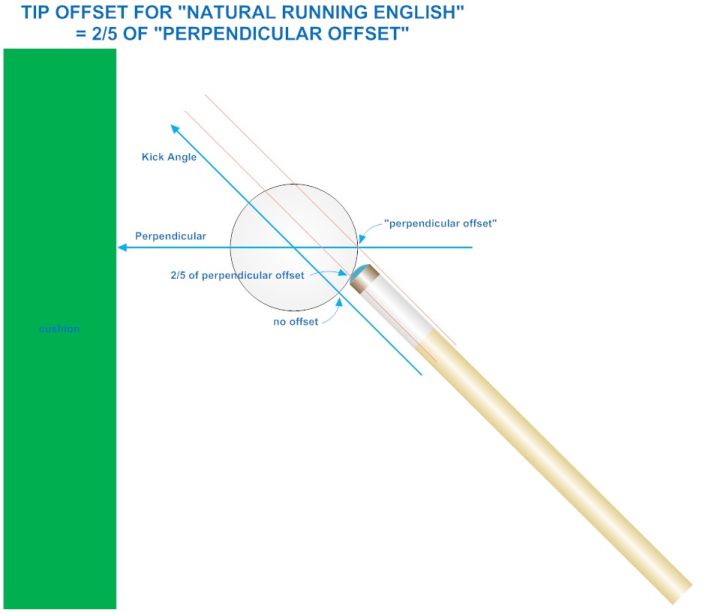
Why do Americans call “side” or “sidespin” “english?”
Here’s the most common story: An Englishman visited the US soon after leather tips were invented. He gave exhibitions showing spin shots previously not possible. People were impressed with these new “English” shots. The name “english” stuck (for any shot using spin on the CB, especially sidespin).
from Bob Jewett (in AZB post):
I think that no one knows for sure.
The best reference for billiard-related words, their origins and meanings, is Mike Shamos’ “New Illustrated Encyclopedia of Billiards.” The earliest example found of the word “English” to mean side spin was in the New York Times in 1873. Shamos points out that the use of side spin was documented in 1806 which pre-dated the invention of the tip by Mingaud (about 1818). Chalk was also used before tips were invented.
Shamos speculates that the usage came about because English visitors introduced side spin. There is a long time between the first use of side spin along with universal use of tips and the first recorded use of “English” to mean side. I’ve also seen a theory that “english” somehow transmogrified from “angled”.
Dr. Dave keeps this site commercial free, with no ads. If you appreciate the free resources, please consider making a one-time or monthly donation to show your support:
